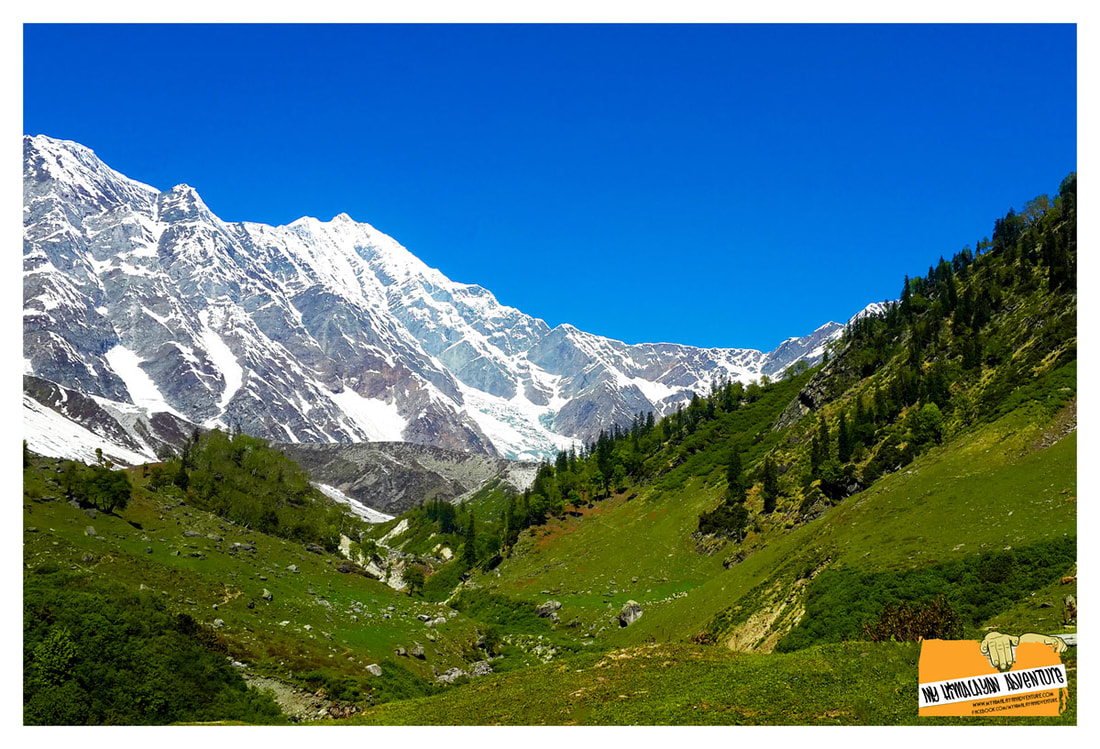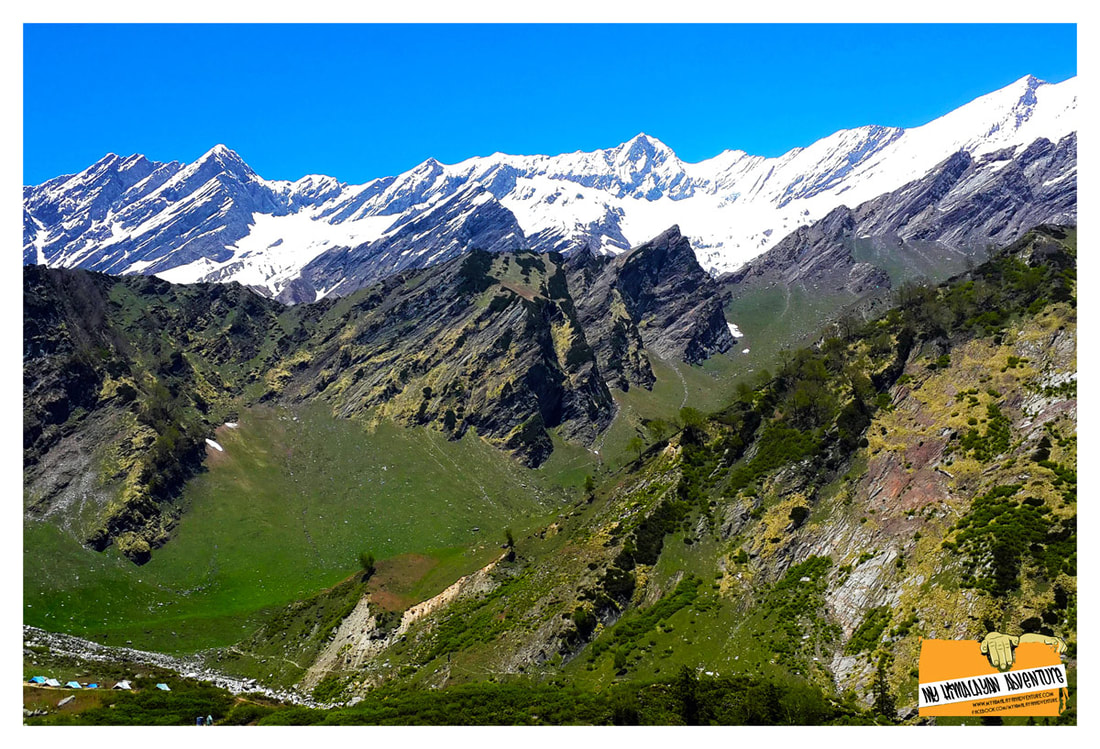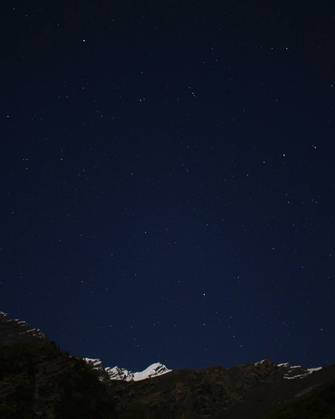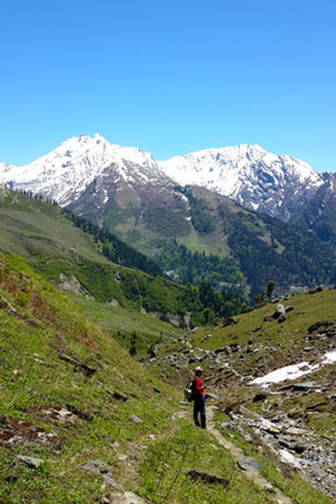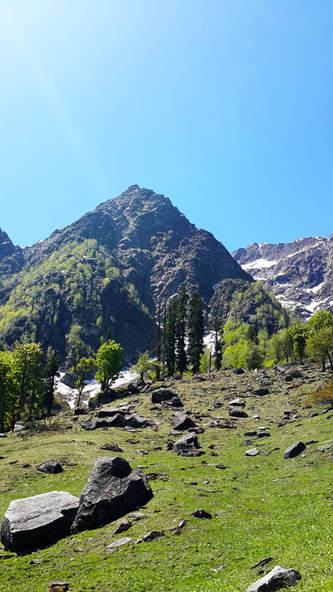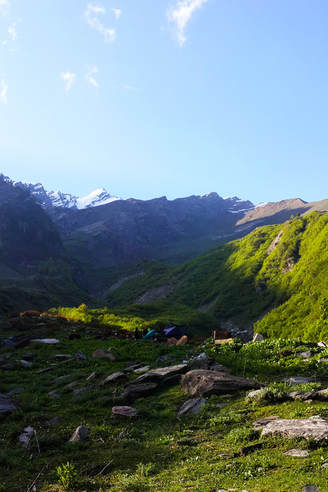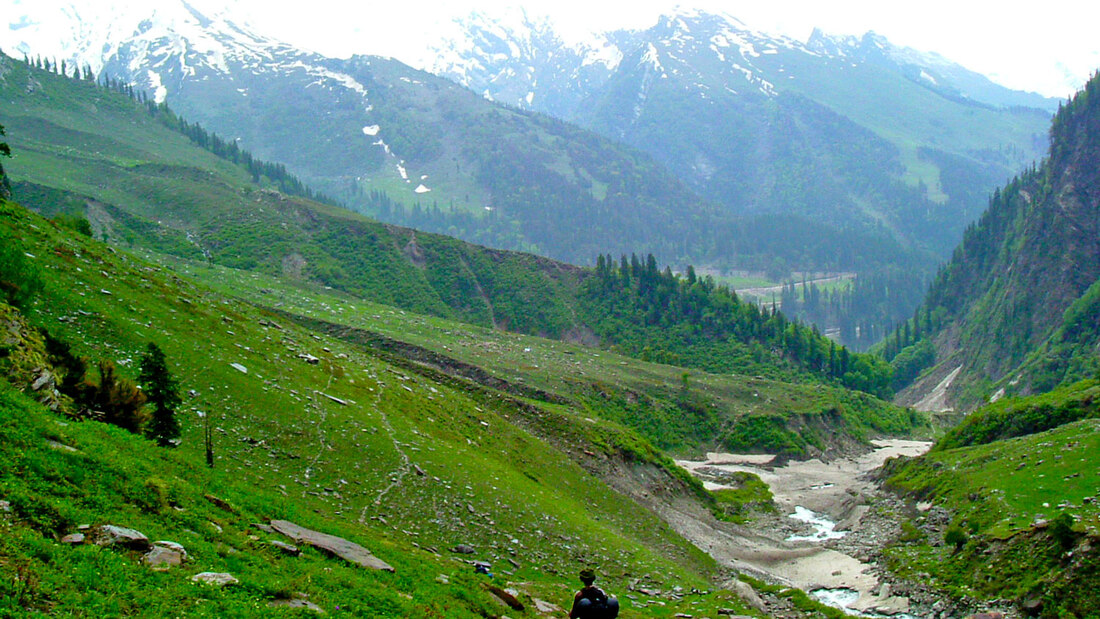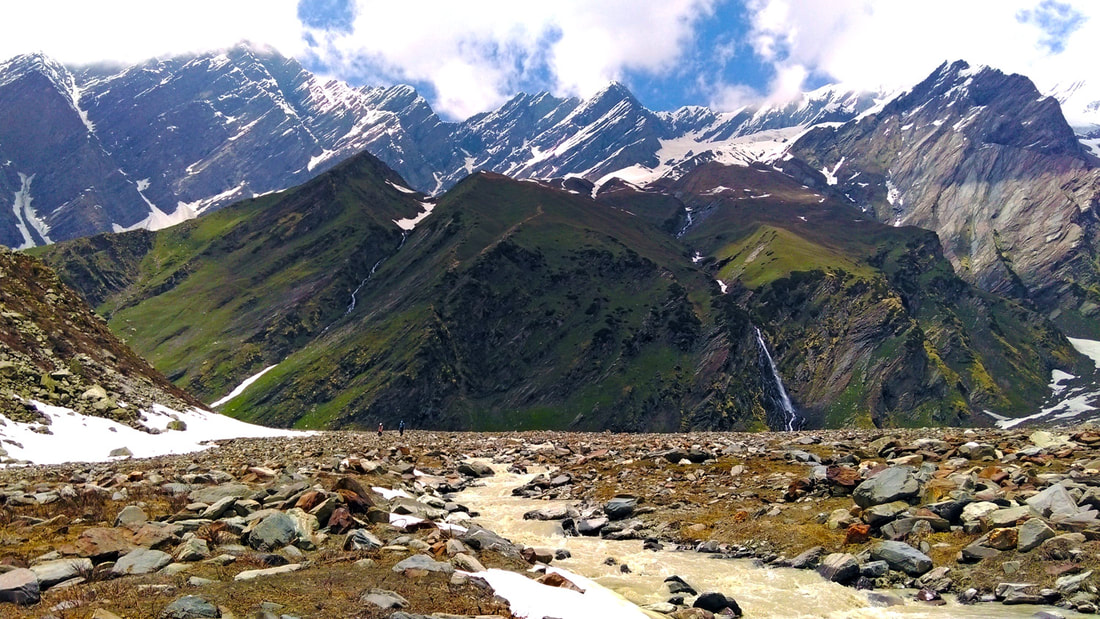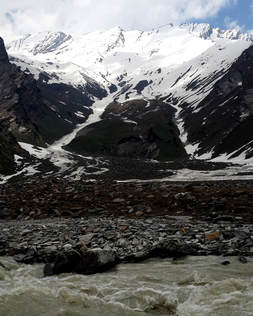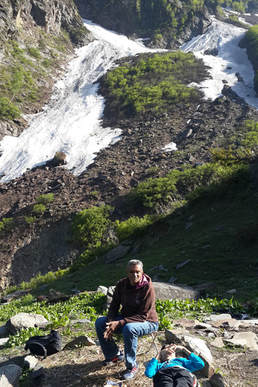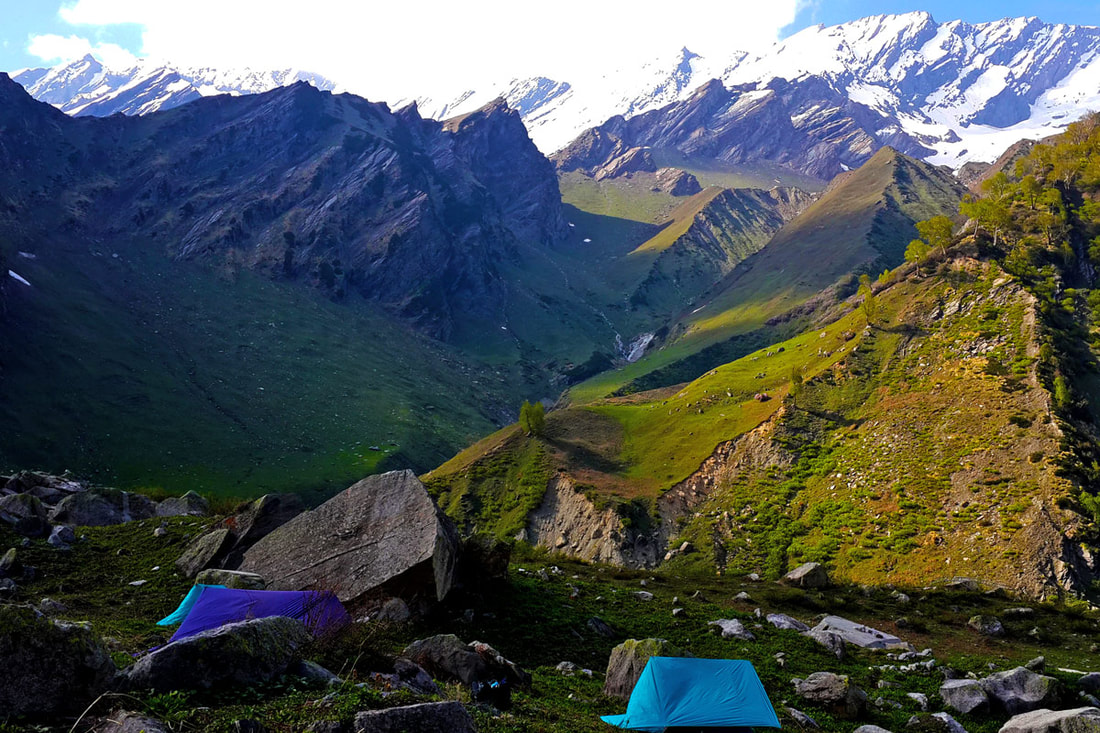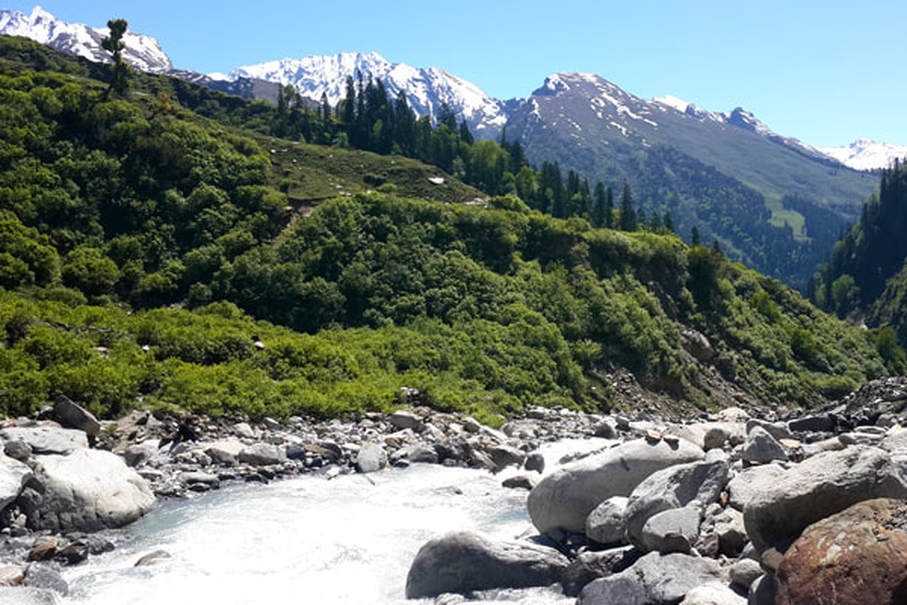Beaskund trek
|
Difficulty level: It can be done by anyone but having a decent fitness level is advised. You will not face much difficulty if you are relatively fit- walk or do some activity regularly.
If you are not that fit then you will be comfortable if you start walking regularly or get physically active in the lead up to the trek. We will be happy to consult you on a good preparation routine. Suitable for children? Yes, suitable for children, but with certain extra precautions for very small children. Certain extra logistical support is also recommended. The youngest kid to do this trek with us and reach Beaskund was 6 years of age then. Happy to give you advice on this No of Days: It can be done in 2-3 days, but we recommend 4 days ex Manali and 2-3 days can get strenuous. Is it a good option for first time trekkers and/or families?: Yes, we can recommend this trek for people with little or no trekking experience and/or families. The trail is well marked and does not have tricky patches. A well planned itinerary for you will also mean it isn't too tiring and you spend more time enjoying the place |
The Beaskund trek is a beginner level trek that takes you closer to glaciers, snow and to the base of 20,000 ft Himalayan mountains in 2 days- quicker than
any other trek in the Himalayas. Reaching the source of an important Indian River adds even greater satisfaction.
The beautiful trail between Dhundhi and Bhakartach, in these images you get an idea of how close you can get to glaciers and snow clad mountains. In the 1st image you can see Mt Deo Tibba in the background and in the 2nd, Mt Shetidhar(6,001 mt). Click the images to enlarge. If you are browsing from your phone, these images will look better if you switch to landscape mode.
-
Our thoughts & pics
-
Trek advice
-
Book or contact us
<
>
|
Region: Himachal Pradesh, trek starting point is about 25 km from Manali Maximum height during the trek: Approx 12,000 ft Distance you need to travel by road in hilly areas: Around 300 km one way. But the roads are quite good. The quality of buses between Delhi and Manali are excellent. You could also fly to Bhutar which is about 40 km from Manali Price range for a fixed departure/custom group with 4+ people: Trek cost is in the range of Rs 1500-1800 per person per day with budget facilities, around 2,200-2,500 per person per day with premium facilities recommended by us-typically more enjoyable. These overheads come down significantly if you are a group of 10+ people. Do get in touch with us to discuss what is more suitable and enjoyable for you. |
Night skies are worth falling in love with during most Himalayan treks and the Beaskund trek is no exception. We clicked this pic at the Dhundhi campsite
|
|
Our opinion of the Beaskund trek:
Because Manali is so deep in the Himalayas, you get close to snow line really quickly and it is for this reason that in only 2 days of trekking towards beaskund you are very close to permanent snow and glaciers. Beaskund is the base camp for people who want to summit Mt Shetidhar and is a camp before base camp for people looking to summit Mt Hanuman Tibba. I hope this gives you an idea of how close you are to the base of prominent Himalayan mountains. At Bhakartach you are almost at the base of Mt Deo Tibba and you will find lots of moraines, hanging glaciers nearby- a great place for snow, rock and ice training. You also get views of some very beautiful green meadows all the way. This trek is particularly suitable for beginners not just because of the proximity to glaciers and snow in a relatively short time but also because the trekking distances are quite short on most of the days. On the first day you are trekking for about 4-5 hours but most of it is on a metalled road- upto Dhundi. This road is being constructed towards a tunnel that will eventually bypass the Rohtang Pass, so vehicles are not permitted beyond Solang unless you have permission. But walking on a metalled road for a large part the first day works as a great warm up for a trekker. Your campsite is about an hour ahead of Dhundi. On the second day you will trek about 2-3 hours to reach beautiful meadow at Bhakartach or relatively well marked and simple terrain. On the third day, you will be trekking along steep and tricky terrain and includes loose moraines, but our guides are well trained and accomplished you comfortably help you negotiate this terrain. The starting point of the trek is Solang- about 20 km from Manali which is a popular hill station and has excellent connectivity with the rest of the country. The most time saving option is to take a flight to Bhuntar(Kullu) which is about 40 km from Manali. You could also look at taking a flight upto Chandigarh or Delhi and taking a taxi/bus from there or a train upto Chandigarh and taxi bus from there. There are a number of very good quality buses between these cities to Manali. The road conditions are also quite good. The distance between Manali and Chandigarh is about 300 km or 7-8 hours. As always, please feel free to contact us for any help in planning this. |
Trekking between Dhundhi and Bhakartach
Pretty much from the start, you will find grassy meadows towered by snow mountains on this trek
|
|
Other info All in all a four to five days from Manali to Manali Add a overnight bus journey if you are from Delhi or Chandigarh and another 2-3 hour flight if you are from Mumbai/ Bangalore or another city and you have an experience on your hands.. When combined with your weekend holidays, you need to take about 2-3 days off from your workplace for this experience. This trek is perfect if you want to be in the thick of the greater Himalayas and really want to get away but don't want the experience to be very tough or tiring. Perfect for a family outing. Your convenience and quality is our priority. We offer a door to door service if you are the laid back types and need that dose of luxury. Here you just need to let us know and we will assist in all the planning for you to reach the base. Including optimizing your time to reach, cost to reach etc. We have also built links in the travel industry to help you get the best prices and have personally vetted a number of transporters and stay options for quality. All planning we do for you to reach the trek base is done at a pass on cost by us and we do not make any profit on it |
|
Suggested Itinerary:
This is the typical itinerary that we recommend if you are not an experienced trekker- if you are coming for the first time, if you want to take it easy and not stress too much, if you are coming with family or children etc. While this trek can be done in shorter time, that can get quite strenuous from our experience. Day 1: Drive from Manali to Solang(1 hour drive), begin the trek from Solang to Dhundi(4-5 hour trek) in well marked and gradual terrain. The campsite is around half an hour ahead of Dhundi Day 2: Trek from Dhundi campsite to Bhakartach(2-3 hour trek) in mostly gradual terrain Day 3: Trek from Bhakartach to Beaskund and back to Bhakartach(3-4 hours up and 2-3 hours down). The terrain is a little tricky with scree and rock patches, need to be careful Day 4: Trek back to Solang, drive back to Manali |
Sounds like a great trek, but what are the things I should consider before going for the Beaskund trek?
How comfortable are you with road travel in the mountains?
Mountain roads are normally quite windy and twisty, occasionally bumpy and for those who are not used to mountains roads, drives may be uncomfortable. Keep this in mind while choosing which trek you are doing and while planning your itinerary. If you are uncomfortable with long drives and think you may get motion sickness, then you could plan a trek with a short travel time in the mountains, or you could look at splitting your travel time into extra days, if not then there are other treks that we can recommend which cut down on travel time. There are also certain suggestions such as taking a car with a low body-roll, home-made remedies that have worked for us that we will be happy to share with you to help you in your journey.
Accessibility is one of the big advantages of the Beaskund trek. The roads on this route are comparatively less windy so the drive is not that difficult. Manali being a popular hill station means that you will get numerous good quality modes of transport at effective prices including local buses, AC Volvo Buses, good taxis etc. You could bypass road travel almost entirely by taking a flight to Bhuntar which is 40 km from Manali and 60 km from the starting point of the trek. If however, you are comfortable with road travel in the mountains then you open up a number of other options as well.
Are you looking at something leisurely or something challenging?
Leisurely treks have well marked trails, have between 2-4 hours of trekking a day and can be managed without much difficulty. These are better for beginners or those who come with the intention of enjoying themselves more than exerting. Challenging treks can have difficult terrain, 6-7 hours of walking a day, go to high altitude and therefore have to plan their itinerary very well so that their body is well acclimatized. They not only require a high fitness level but high mental endurance.
On less challenging treks we are also able to offer better facilities because carrying things up is easier and less expensive. Facilities get more basic as the trek challenge levels go up because carrying additions gets harder.
Typically, if you want your first taste of the mountains and Himalayan wilderness, then we recommend a more leisurely trek and you will enjoy that trek much more. Too much challenge first time may put you or your family off. Take is slow is what we suggest. Start with a leisurely trek where you aren't that exposed to the extremes, can spend more time at camp with your loved ones, enjoy the great food, the scenery, walk around, click photographs, play some games et so that you soak in the experience. On challenging treks you are likely to be too tired to do most of this stuff.
The Beaskund trek is somewhat leisurely the first two days are relatively short and not very tiring. The third day when you trek from Bhakartach to Beaskund is a long day of walking with tricky terrain but since you return to Bhakartach it is optional and the less fit in the group can skip it. So we will categorize this as leisurely. You can make customizations to make it more challenging.
Are you coming with a family/young kids who you want to initiate to the Himalayas?
On similar lines with our previous point. If you are coming with family/trying to initiate your children to the Himalayas, the first experience should not be to difficult that puts them off. Keep the first experience light which gives them limited exposure where they are spending more time enjoying their surroundings.
For reasons mentioned above, if you are in this category then the Beaskund trek is among our more recommended treks.
What sort of terrain do you like? Glaciers/meadows/forests/villages?
This is a personal choice without any right or wrong answers. Some may prefer glaciers and base of mountains with permanent snow, others may want meadows and forests, others will want to spend time in local villages.
On the Beaskund trek you get some of the closest views of glaciers and permanent snow among alot of other treks. Snow peaks are visible from day 1 itself and as you continue trekking you reach very close to the base of prominent mountains including Deo Tibba, hanuman Tibba, Shetidhar and Friendship Peak. The meadows on the way are also very beautiful. But there are no villages on the way, so that aspect of Himalayas- Rural villages is something you will not experience here and you will not go through particularly dense forests. If you prefer those aspects of the Himalayas then there are other treks that we can recommend.
Also, you are likely to come across a number of trekkers on route and other campsites. So if you prefer peaceful treks where you won't find too many people then there are other treks or a different route on this trek.
How many days do you have?
You need at least 4 days of trekking time for the Beaskund trek. While you can do the trek in a shorter span of time, we do not entirely recommend that as it may get hectic if you are a less experienced trekker. Combined with travel time, you need 5-6 days to do this from Delhi/Mumbai/Bangalore if planned well. Happy to help you in planning this.
Time of the year?
If you want snow then a good time to do this trek is March and April. May is also a good time as the temperature is just right, so is October and November as it is just post monsoon and there is very lush greenery, great colour saturation and mostly very clear skies- excellent for photography and star gazing. But May and June are also popular times so you will find other trekkers on route. You will find Rhododendron flowers in full bloom if you do this trek in March-April train booking to reach Dehradun/Haridwar will need to be done well in advance. You will find Rhododendron flowers in full bloom if you do this trek in March-April
Budget?
Trekking can be expensive. You are paying for your flights, booking a taxi to get to the trek base and then the trek. Because everything needs to carried up, because we have highly trained staff and include all facilities to make your experience enjoyable, there is a decent cost to trekking.
While there are companies that are doing treks at low costs, there are certain compromises to quality that we do not make to our facilities, to the number of people we take in our fixed departures to ensure a personalized experience.
We have mentioned the price brackets for the Beaskund trek in the previous page, while we can do it at budget facilities, more premium facilities at a slightly higher cost are what we recommend because we have tailor made them to maximize enjoyment in the mountains.
Training: While anyone with a decent fitness level can do this trek, we recommend a good fitness routine in the lead up to the trek, it always helps. We also recommend that you continue with this fitness routine after the trek is done. Use this trek as a beginning to healthier times :)
How comfortable are you with road travel in the mountains?
Mountain roads are normally quite windy and twisty, occasionally bumpy and for those who are not used to mountains roads, drives may be uncomfortable. Keep this in mind while choosing which trek you are doing and while planning your itinerary. If you are uncomfortable with long drives and think you may get motion sickness, then you could plan a trek with a short travel time in the mountains, or you could look at splitting your travel time into extra days, if not then there are other treks that we can recommend which cut down on travel time. There are also certain suggestions such as taking a car with a low body-roll, home-made remedies that have worked for us that we will be happy to share with you to help you in your journey.
Accessibility is one of the big advantages of the Beaskund trek. The roads on this route are comparatively less windy so the drive is not that difficult. Manali being a popular hill station means that you will get numerous good quality modes of transport at effective prices including local buses, AC Volvo Buses, good taxis etc. You could bypass road travel almost entirely by taking a flight to Bhuntar which is 40 km from Manali and 60 km from the starting point of the trek. If however, you are comfortable with road travel in the mountains then you open up a number of other options as well.
Are you looking at something leisurely or something challenging?
Leisurely treks have well marked trails, have between 2-4 hours of trekking a day and can be managed without much difficulty. These are better for beginners or those who come with the intention of enjoying themselves more than exerting. Challenging treks can have difficult terrain, 6-7 hours of walking a day, go to high altitude and therefore have to plan their itinerary very well so that their body is well acclimatized. They not only require a high fitness level but high mental endurance.
On less challenging treks we are also able to offer better facilities because carrying things up is easier and less expensive. Facilities get more basic as the trek challenge levels go up because carrying additions gets harder.
Typically, if you want your first taste of the mountains and Himalayan wilderness, then we recommend a more leisurely trek and you will enjoy that trek much more. Too much challenge first time may put you or your family off. Take is slow is what we suggest. Start with a leisurely trek where you aren't that exposed to the extremes, can spend more time at camp with your loved ones, enjoy the great food, the scenery, walk around, click photographs, play some games et so that you soak in the experience. On challenging treks you are likely to be too tired to do most of this stuff.
The Beaskund trek is somewhat leisurely the first two days are relatively short and not very tiring. The third day when you trek from Bhakartach to Beaskund is a long day of walking with tricky terrain but since you return to Bhakartach it is optional and the less fit in the group can skip it. So we will categorize this as leisurely. You can make customizations to make it more challenging.
Are you coming with a family/young kids who you want to initiate to the Himalayas?
On similar lines with our previous point. If you are coming with family/trying to initiate your children to the Himalayas, the first experience should not be to difficult that puts them off. Keep the first experience light which gives them limited exposure where they are spending more time enjoying their surroundings.
For reasons mentioned above, if you are in this category then the Beaskund trek is among our more recommended treks.
What sort of terrain do you like? Glaciers/meadows/forests/villages?
This is a personal choice without any right or wrong answers. Some may prefer glaciers and base of mountains with permanent snow, others may want meadows and forests, others will want to spend time in local villages.
On the Beaskund trek you get some of the closest views of glaciers and permanent snow among alot of other treks. Snow peaks are visible from day 1 itself and as you continue trekking you reach very close to the base of prominent mountains including Deo Tibba, hanuman Tibba, Shetidhar and Friendship Peak. The meadows on the way are also very beautiful. But there are no villages on the way, so that aspect of Himalayas- Rural villages is something you will not experience here and you will not go through particularly dense forests. If you prefer those aspects of the Himalayas then there are other treks that we can recommend.
Also, you are likely to come across a number of trekkers on route and other campsites. So if you prefer peaceful treks where you won't find too many people then there are other treks or a different route on this trek.
How many days do you have?
You need at least 4 days of trekking time for the Beaskund trek. While you can do the trek in a shorter span of time, we do not entirely recommend that as it may get hectic if you are a less experienced trekker. Combined with travel time, you need 5-6 days to do this from Delhi/Mumbai/Bangalore if planned well. Happy to help you in planning this.
Time of the year?
If you want snow then a good time to do this trek is March and April. May is also a good time as the temperature is just right, so is October and November as it is just post monsoon and there is very lush greenery, great colour saturation and mostly very clear skies- excellent for photography and star gazing. But May and June are also popular times so you will find other trekkers on route. You will find Rhododendron flowers in full bloom if you do this trek in March-April train booking to reach Dehradun/Haridwar will need to be done well in advance. You will find Rhododendron flowers in full bloom if you do this trek in March-April
Budget?
Trekking can be expensive. You are paying for your flights, booking a taxi to get to the trek base and then the trek. Because everything needs to carried up, because we have highly trained staff and include all facilities to make your experience enjoyable, there is a decent cost to trekking.
While there are companies that are doing treks at low costs, there are certain compromises to quality that we do not make to our facilities, to the number of people we take in our fixed departures to ensure a personalized experience.
We have mentioned the price brackets for the Beaskund trek in the previous page, while we can do it at budget facilities, more premium facilities at a slightly higher cost are what we recommend because we have tailor made them to maximize enjoyment in the mountains.
Training: While anyone with a decent fitness level can do this trek, we recommend a good fitness routine in the lead up to the trek, it always helps. We also recommend that you continue with this fitness routine after the trek is done. Use this trek as a beginning to healthier times :)
Interested? Do get in touch with us, we would love to hear from you
|
|
Trekking with
|
